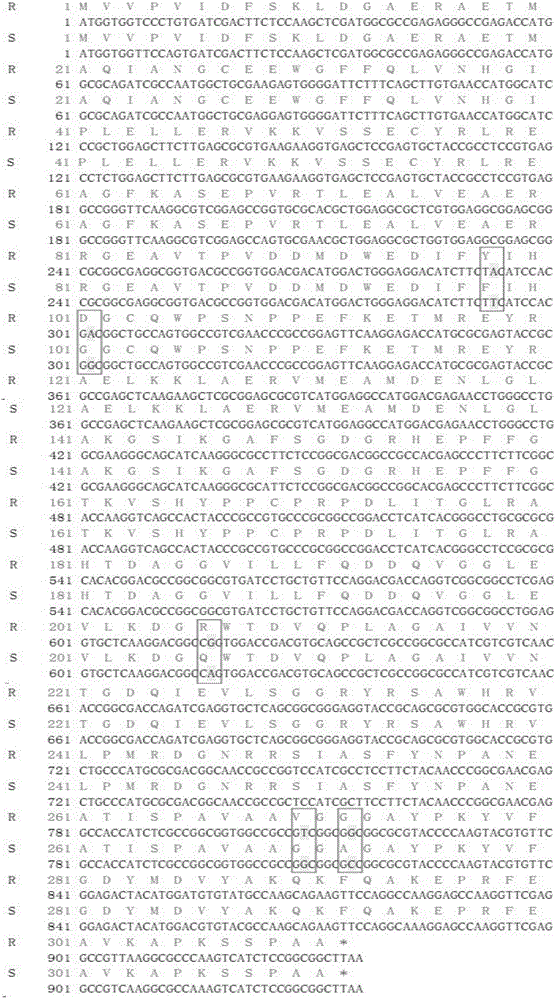1-aminocyclopropane-1-carboxylate oxidase contained in drug-resistant barnyard grass and coding gene, mutation site and application thereof
An aminocyclopropane, coding gene technology, applied in the field of plant biology, can solve problems such as no report, no clone of ACO gene, few ACO, etc., to achieve the effect of improving drug resistance
- Summary
- Abstract
- Description
- Claims
- Application Information
AI Technical Summary
Problems solved by technology
Method used
Image
Examples
Embodiment 1
[0035] Example 1. Cloning of the EcACO gene in drug-resistant barnyardgrass and sensitive barnyardgrass and its sequence difference analysis
[0036] The quinclorac-resistant barnyardgrass and sensitive barnyardgrass materials at the 2-3 leaf stage were selected, and the nucleotide and amino acid sequences of their EcACO genes were compared and analyzed.
[0037] 1. Extraction of barnyardgrass total RNA. Using quinclorac-resistant barnyardgrass and sensitive barnyardgrass as research materials, total RNA was extracted from single barnyardgrass seedlings cultured to the 2-3 leaf stage and sensitive barnyardgrass seedlings respectively. Barnyardgrass total RNA was extracted using an ultra-pure total RNA rapid extraction kit (purchased from Yuanping Hao Biotechnology Co., Ltd.), and the operation method was referred to the kit instruction manual. The extracted barnyardgrass total RNA was subjected to 1% agarose electrophoresis to detect the quality and integrity of the RNA, and ...
Embodiment 2
[0042] Example 2. Real-time quantitative PCR analysis of the EcACO gene in drug-resistant barnyardgrass and sensitive barnyardgrass
[0043] Select quinclorac-resistant barnyardgrass and sensitive barnyardgrass materials at the 2-3 leaf stage, and use real-time quantitative PCR (quant itat ive real-time PCR) to analyze the expression level of EcACO gene in these materials, so as to obtain the EcACO gene Relationship between expression levels and quinclorac resistance.
[0044] 1. Extraction of barnyardgrass total RNA. Using quinclorac-resistant barnyardgrass and sensitive barnyardgrass as research materials, total RNA was extracted from single barnyardgrass seedlings cultured to the 2-3 leaf stage and sensitive barnyardgrass seedlings respectively. Barnyardgrass total RNA was extracted using an ultra-pure total RNA rapid extraction kit (purchased from Yuanping Hao Biotechnology Co., Ltd.), and the operation method was referred to the kit instruction manual. The extracted bar...
Embodiment 3
[0047] Example 3. Determination of EcACO Enzyme Activity in Drug-resistant Barnyard Grass and Sensitive Barnyard Grass and Its Difference Comparison
[0048] The quinclorac-resistant barnyardgrass and sensitive barnyardgrass materials at the 2-3 leaf stage were selected, and the enzyme activity of EcACO in these materials was analyzed by the method of Yusuke Kosugi et al. (2014).
[0049] 1. Prokaryotic expression vector construction. The designed primer is EcACO-NdeI-S:5'-GGTATATA CATATG GTGGTTCCAGTGATCG-3' (the underline is the restriction endonuclease NdeI restriction site recognition sequence); EcACO-NdeI-R:5'-GGTATATA CATATG GTGGTCCCTGTGATCG-3' (the underline is the restriction endonuclease NdeI restriction site recognition sequence); EcACO-EcoRV:5'-GGCTCTCA GATATC TCATTAAGCCGCCGGAG-3' (underlined is EcoRV restriction site recognition sequence). The EcACO-R gene and the EcACO-S gene were respectively constructed into the prokaryotic expression vector plasmid pMAL-c5...
PUM
 Login to View More
Login to View More Abstract
Description
Claims
Application Information
 Login to View More
Login to View More - R&D
- Intellectual Property
- Life Sciences
- Materials
- Tech Scout
- Unparalleled Data Quality
- Higher Quality Content
- 60% Fewer Hallucinations
Browse by: Latest US Patents, China's latest patents, Technical Efficacy Thesaurus, Application Domain, Technology Topic, Popular Technical Reports.
© 2025 PatSnap. All rights reserved.Legal|Privacy policy|Modern Slavery Act Transparency Statement|Sitemap|About US| Contact US: help@patsnap.com



